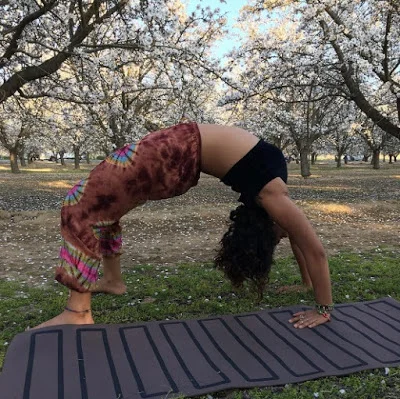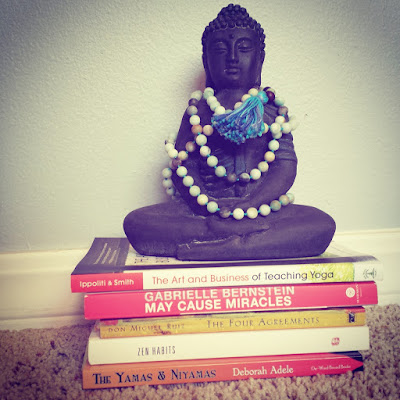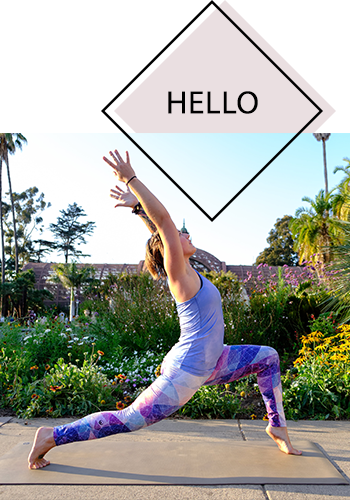Welcome to a new series on Alive in the Fire dedicated to Badass Yoga Teachers!
Today I'm sharing five of my favorite books that have influenced my path as a yoga teacher.
These books offer wonderful tools for:
- building your yoga career
- understanding the ethical principles of yoga
- exploring who you are and what motivates you to teach
- overcoming fear
- forming new habits
Whether you're an experienced yoga teacher, new to teaching, or thinking about becoming a teacher, these are wonderful books to explore. May they encourage you on your path as you evolve and grow :)
The Art and Business of Teaching Yoga by Amy Ippoliti and Taro Smith
'Wow.' That's what I kept saying to myself as I read this book. And also, 'This book should be required reading in any yoga teacher training!'
Amy Ippoliti and Taro Smith offer an incredible wealth of knowledge about yoga, teaching, and business in this book. They are successful teachers and created 90 Monkeys, an online school that is focused on helping yoga professionals develop their careers.
Early in the book, the authors describe the 'vicious cycle of yoga teaching:'
- Run all over town teaching eighteen or more classes a week to make ends meet.
- Oops, no time for your own practice! No time to plan classes!
- Teach subpar class because of lack of practice, inspiration, or groundedness.
- Get home, have no time for reflection, fun, recreation, or family.
- Get up the next day with even less inspiration, and teach to a dwindling number of students.
- Make insufficient money to pay bills, afford necessary continuing education, or have much-needed free time.
- Repeat.
When I read these statements, I couldn't help but laugh (and cry inside, a little) realizing how true these felt, as I've experienced some of them and witnessed friends and fellow teachers struggling with the same cycle.
I love that this book addresses many relevant topics and gives real-world advice for how to overcome the obstacles that many yoga teachers face.
Here are some of the subjects covered in the book:
- understanding your strengths (and potential weaknesses) as a teacher
- developing a mission statement to help focus and hone your teaching
- building and marketing your personal yoga business
- managing your business finances
- how to avoid burnout
- how to use social media to promote your teaching
- self-care
- lighting up the world
Highly recommend this book! If you're a stressed out yoga teacher, read this. If you want to understand some of the practical realities of what it means to teach full-time or whether you should quit your day job to start teaching, read this. If you're curious about how to create a fulfilling career as a yoga teacher, read this. XO
May Cause Miracles by Gabrielle Bernstein
This book changed my life when I first read it in 2014; it inspired me to dedicate the following year to being a fearless 2015, and also gave me the energy and willingness to leave my 9-to-5 job to teach yoga and freelance.
Here I am halfway through 2016 experiencing some big shifts again, and I'm re-reading this book as a way to reconnect with many of its relevant themes: releasing fear, increasing mindfulness, cultivating self-acceptance and radical self-love. I have a feeling I'll keep coming back to this book over and over again, because doing this work truly does cultivate subtle shifts which lead to miraculous change.
Gabrielle Bernstein's work speaks to my heart, and her writing is encouraging, thoughtful, real, and uplifting. She has a way of helping me look at things I don't really want to look at, of facing my fears, and I think that has been most powerful alongside my yoga teaching.
I encourage yoga teachers to try this book because I believe self-healing is needed every step of the way: when we make the courageous decision to become a yoga teacher, as we are immersed in the rigors of a 200 hour training (or 300, 500, 800 hour!), as we step into the studio to teach our first, or hundredth class, as we grow and evolve over time, contributing to our yoga communities.
Everything that goes along with teaching yoga will bring up emotion, ego, insecurities, and doubts-- whether you're being vulnerable with students, being vulnerable and real with yourself, receiving feedback from fellow teachers or studio owners, questioning why you teach, fine-tuning your classes, or seeing your numbers dwindle or skyrocket.
This book offers simple tools to help you understand yourself along the way, to let go of fear, to cultivate abundance, and to believe, even just a little bit, in how much of a miracle you are.
As Gabrielle says, "Welcome to your new life!"
The Four Agreements by Don Miguel Ruiz
The Four Agreements is a beautiful, artful book that explores self-limiting beliefs. Ruiz draws on ancient Toltec wisdom, outlining a powerful code of conduct that has the potential to free us from suffering and experience a life of happiness and love.
I believe these four principles offer me powerful wisdom in my daily life as well as my yoga teaching.
- Be impeccable with your word.
- Don't take anything personally.
- Don't make assumptions.
- Always do your best.
A beautiful book, not to be missed!
Zen Habits by Leo Babauta
Leo's blog Zen Habits is my absolute favorite blog, so of course when I heard that he was publishing a book based on the topics he often writes about, I was stoked! This book offers an incredible method for transforming any area of your life, and for dealing with any life changes, loss, illness, frustrations with others, and unhappiness with ourselves.
In the book, Leo outlines simple, beautiful ways to:
- become more mindful
- embrace change
- create space and deal with things as they come up
- release attachment
- focus on intentions
- foster appreciation and gratitude
All very yogic topics!
I'd suggest this book to anyone, yoga teacher or not, and especially if you're a teacher and looking to:
- create a consistent home practice even while you teach a full load of classes
- establish healthy boundaries as you build relationships with your students and studio managers
- feel more peaceful in your own life
- embrace discomfort
Zen Habits is one of my all-time favorite books.
The Yamas and Niyamas by Deborah Adele
I read this book during my 200-hour vinyasa yoga teacher training and found it to be a wonderful, thorough guide to the yamas and niyamas, yoga's ten ethical guidelines.
I especially love Deborah's writing prompts at the end of each chapter, which encourage the reader to do self-study and learn to apply these ideas to real life.
I love this book and have often read from it to my students at the end of class. I believe it is important for all yoga teachers to explore and develop their own personal understandings of the yamas and niyamas:
- ahimsa (nonviolence)
- satya (truthfulness)
- asteya (nonstealing)
- brahmacharya (nonexcess)
- aparigraha (nonposessiveness)
- saucha (purity)
- santosha (contentment)
- tapas (self-discipline)
- svadhyaya (self-study)
- ishvara pranidhana (surrender)
Here's one of my favorite passages from the introduction of the book:
"We all want to live well. Let's face it, at the end of the day, it's not how much you have or how much you have accomplished that counts. What matters is how well you have participated in your own life, both the ordinary routines and the extraordinary surprises. It's how you feel inside when you lay your head on the pillow."
This book is a wonderful tool for cultivating inner peace and developing a strong sense of integrity, both as a yoga teacher and a human being.
Well, yoga teachers and soon-to-be teachers, I hope these books offer you some incredible insight into your own lives, both on and off the yoga mat! XO
PS, I'd love to hear: what are some of your favorite yoga books?



















































This post is for all the new yoga teachers out there.